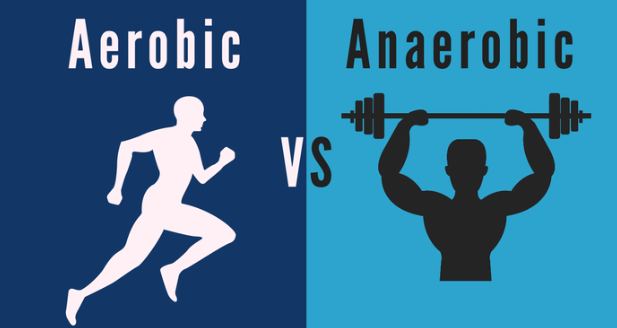When it comes to physical fitness, there are various types of exercise to consider. Two primary categories are aerobic vs. anaerobic exercise, each offering unique benefits and considerations. Understanding the differences between these two types of exercise can help you make informed decisions about your fitness routine and optimize your health and fitness goals. In this article, we will explore the definitions of aerobic and anaerobic exercise, the science behind how they work, the pros and cons of each, their effectiveness for weight loss, and the overall health benefits.
We will also discuss safety considerations and provide guidance on how to incorporate both types of exercise into your routine to achieve a balanced and effective fitness regimen.

Understanding the Basics
Before diving into the specifics of aerobic and anaerobic exercise, it’s important to understand their definitions and how they differ.
Definition of Aerobic Exercise
Aerobic exercise, also known as cardiovascular exercise, refers to any activity that stimulates and strengthens the heart and lungs, promoting improved oxygen utilization by the body. During aerobic exercise, the body utilizes oxygen to produce energy, primarily by breaking down carbohydrates and fats. This type of exercise is typically performed at a moderate intensity for a sustained period, such as jogging, cycling, swimming, or aerobic dance.
Definition of Anaerobic Exercise
Anaerobic exercise, on the other hand, involves high-intensity, short-duration activities that push the body to its limits and rely on energy sources stored within the muscles. Unlike aerobic exercise, anaerobic exercise does not rely on oxygen for energy production.
The Science Behind the Sweat
To understand the differences between aerobic and anaerobic exercise, it’s essential to grasp how they work on a physiological level.
How Aerobic Exercise Works
During aerobic exercise, the body’s demand for oxygen increases, leading to deeper and faster breathing. This increased oxygen intake fuels the muscles, allowing them to contract repeatedly and maintain a steady pace over a more extended period. As a result, aerobic exercise strengthens the heart and lungs, improves cardiovascular endurance, and boosts overall fitness. It also helps burn calories, manage weight, reduce the risk of chronic diseases like heart disease and diabetes, and improve mental well-being.
How Anaerobic Exercise Works
Anaerobic exercise, being high-intensity and short-duration in nature, relies on energy sources stored in the muscles. The body taps into glycogen, a stored form of glucose, to produce energy without requiring oxygen. This energy system is rapidly depleted, limiting the duration of anaerobic activities. However, anaerobic exercise offers benefits such as increased muscle strength, power, and speed. It stimulates the growth and development of muscle tissue, enhances bone density, and boosts metabolism.
Pros and Cons of Aerobic Exercise

Pros
- Improved cardiovascular health: Aerobic exercise strengthens the heart and improves circulation, reducing the risk of heart disease.
- Increased endurance: Regular aerobic exercise improves stamina, allowing you to engage in activities for more extended periods without feeling fatigued.
- Weight management: Aerobic exercise helps burn calories and fat, supporting weight loss and weight maintenance.
- Stress relief: Engaging in aerobic activities releases endorphins, which promote relaxation and alleviate stress.
- Enhanced mental well-being: Aerobic exercise has been linked to improved mood, reduced symptoms of depression and anxiety, and enhanced cognitive function.
Cons
- Limited muscle development: While aerobic exercise helps tone muscles, it may not provide the same level of muscle growth and strength as anaerobic exercise.
- Potential joint impact: Certain high-impact aerobic activities, such as running or jumping, may place stress on the joints, increasing the risk of injury.
- Plateau effect: Over time, the body may adapt to aerobic exercises, leading to a plateau in fitness gains. It’s essential to vary your workouts to continue challenging your body.
Pros and Cons of Anaerobic Exercise

Pros
- Increased muscle strength and power: Anaerobic exercise, such as weightlifting, helps build and strengthen muscles, improving overall physical strength and power.
- Improved bone density: The high impact and resistance involved in anaerobic exercise help stimulate bone growth, reducing the risk of osteoporosis.
- Boosted metabolism: Anaerobic exercise, particularly high-intensity interval training (HIIT), elevates the metabolic rate, leading to increased calorie burning even after the workout is complete.
- Time efficiency: Anaerobic workouts can be completed in a shorter amount of time compared to longer aerobic sessions, making them ideal for individuals with busy schedules.
Cons
- Increased risk of injury: The intensity of anaerobic exercises puts additional stress on the muscles and joints, making proper form and technique crucial to prevent injury.
- Limited cardiovascular benefits: While anaerobic exercise offers muscle-building benefits, it may not provide the same cardiovascular and endurance improvements as aerobic exercise.
- Longer recovery time: Due to the intense nature of anaerobic exercise, the body requires adequate rest and recovery time between sessions to allow the muscles to repair and rebuild.
Effectiveness for Weight Loss: Aerobic vs. Anaerobic Exercise
One common question when it comes to difference between aerobic and anaerobic exercise is their effectiveness for weight loss. Both types of exercise can contribute to weight management, but they have different effects on the body.
Aerobic exercise is highly effective for burning calories and fat, making it beneficial for weight loss. Engaging in activities such as jogging, swimming, or cycling for extended periods helps create a calorie deficit, which is necessary for shedding pounds. Additionally, aerobic exercise helps improve overall cardiovascular health, leading to enhanced fitness and increased endurance.
Anaerobic exercise, although not primarily focused on calorie burning during the activity, offers long-term weight loss benefits. High-intensity anaerobic exercise, like weightlifting and HIIT, builds lean muscle mass. Muscle tissue is metabolically active, meaning it burns more calories at rest compared to fat tissue. By increasing muscle mass through anaerobic exercise, you can boost your basal metabolic rate and increase calorie burning throughout the day.
To maximize weight loss and overall fitness, it’s beneficial to incorporate both aerobic and anaerobic exercises into your routine. Combining cardio activities with strength training can provide a well-rounded approach that supports weight management and overall health.
Comparing the Health Benefits
Both aerobic and anaerobic exercise offer numerous health benefits, and their combination can lead to optimal fitness. Here’s a comparison of the health benefits associated with each type of exercise:
Aerobic Exercise Health Benefits:
- Improved cardiovascular health
- Increased endurance and stamina
- Weight management and fat burning
- Stress relief and improved mental well-being
Anaerobic Exercise Health Benefits:
- Increased muscle strength and power
- Improved bone density
- Boosted metabolism and increased calorie burning
- Time efficiency for busy individuals
- Enhanced body composition and muscle definition
Safety Considerations and Risks
When engaging in any form of exercise, it’s essential to prioritize safety to prevent injury and ensure long-term well-being. Here are some safety considerations for aerobic and anaerobic exercise:
Aerobic Exercise Safety Considerations:
- Start slowly: Begin with lower intensity workouts and gradually increase the duration and intensity over time.
- Proper footwear: Wear appropriate shoes that provide support and cushioning for your chosen aerobic activities.
- Warm-up and cool-down: Always warm up before aerobic exercise and cool down afterward to prepare and recover your muscles.
- Hydration: Stay adequately hydrated before, during, and after aerobic exercise, especially in warm weather or intense workouts.
Anaerobic Exercise Safety Considerations:
- Technique and form: Learn proper form and technique for each exercise to avoid injury. Consider working with a qualified trainer or coach to ensure correct execution.
- Gradual progression: Start with lighter weights or lower intensity exercises and gradually increase as your strength and fitness improve.
- Rest and recovery: Allow sufficient rest between anaerobic workouts to allow the muscles to repair and recover.
- Adequate nutrition: Fuel your body with proper nutrition to support muscle growth and recovery.
- Joint care: Pay attention to joint health and avoid excessive stress or strain on joints during anaerobic exercises.
How to Incorporate Aerobic and Anaerobic Exercise Into Your Routine
To experience the benefits of both aerobic and anaerobic exercise, it’s important to incorporate both types into your fitness routine. Here are some tips on how to do that:
- Schedule your workouts: Plan specific days for aerobic activities like running or swimming and separate days for anaerobic exercises such as weightlifting or HIIT.
- Combine activities: Try integrating activities that incorporate both aerobic and anaerobic components, such as circuit training or interval workouts.
- Alternate days: Designate certain days for aerobic exercise and other days for anaerobic exercise, allowing for proper rest and recovery.
- Consider cross-training: Engage in different activities to target various muscle groups and energy systems. For example, alternate between cycling and strength training or swimming and yoga.
- Seek professional guidance: Consult a fitness professional or personal trainer to help design a well-rounded workout plan that includes both aerobic and anaerobic exercises tailored to your goals and fitness level.
Personalizing Your Fitness: Finding the Right Balance
The “best” exercise routine ultimately depends on your individual goals, preferences, and overall health. Some individuals may benefit from a higher emphasis on aerobic exercise, while others may lean more towards anaerobic activities. It’s crucial to listen to your body, assess your goals, and work with a healthcare professional or fitness expert to personalize your fitness routine accordingly.
By finding the right balance between aerobic and anaerobic exercise, you can optimize your overall fitness, maintain a healthy weight, improve cardiovascular health, enhance muscle strength and endurance, and support your overall well-being.
Conclusion: Which is Best?
When it comes to aerobic vs. anaerobic exercise, it’s not a matter of choosing one over the other. Both types of exercise offer unique benefits that contribute to overall health and fitness. Aerobic exercise is excellent for cardiovascular health, endurance, and weight management, while anaerobic exercise focuses on muscle strength, power, and metabolic benefits.
To experience the full range of benefits, it’s recommended to incorporate both aerobic and anaerobic exercises into your fitness routine. By finding the right balance and considering your goals and preferences, you can create a well-rounded exercise regimen that supports your overall health and fitness journey. Remember to prioritize safety, listen to your body, and consult professionals when necessary.


